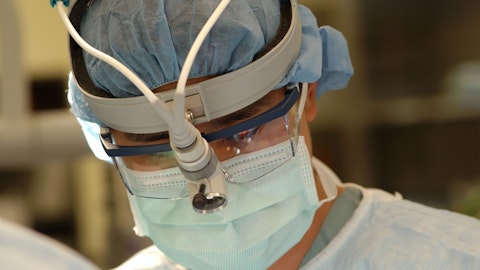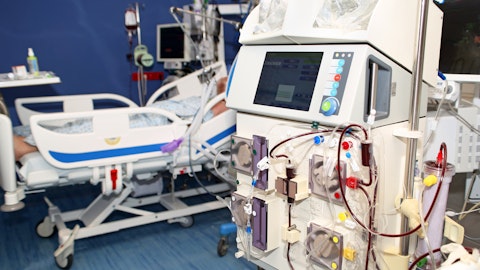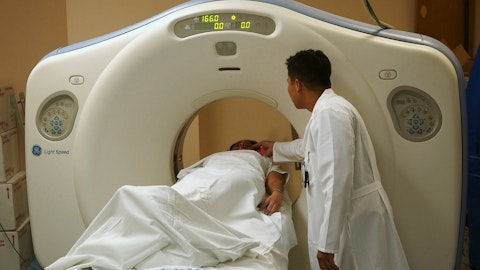AMN Healthcare Services, Inc. (NYSE:AMN) Q2 2023 Earnings Call Transcript August 3, 2023
AMN Healthcare Services, Inc. misses on earnings expectations. Reported EPS is $1.55 EPS, expectations were $2.15.
Operator: Good day, and thank you for standing by. Welcome to AMN Healthcare Second Quarter 2023 Earnings Call. At this time, all participants are in a listen-only mode. After the speakers’ presentation, there will be a question-and-answer session. [Operator Instructions]. Finally, please be advised that today’s conference is being recorded. I would now like to hand the conference over to your speaker today, Randy Reece, Senior Director of Investor Relations. Please go ahead.
Randy Reece: Good afternoon, everyone. Welcome to AMN Healthcare’s Second Quarter 2023 Earnings Call. A replay of this webcast will be available at ir.amnhealthcare.com following the conclusion of this call. Various remarks we make during this call about future expectations, projections, trends, plans, events or circumstances constitute forward-looking statements. These statements reflect the company’s current beliefs based upon information currently available to it. Our actual results may differ materially from those indicated by these forward-looking statements because of various factors and cautionary statements, including those identified in our most recently filed Forms 10-K and 10-Q our earnings release and subsequent filings with the SEC.
The company does not intend to update guidance or any forward-looking statements provided today prior to its next earnings release. This call contains certain non-GAAP financial information. Information regarding and reconciliations of these non-GAAP measures to the most directly comparable GAAP measures are included in our earnings release and on our financial reports page at ir.amnhealthcare.com. On the call today are Cary Grace, Chief Executive Officer; Jeff Knudson, Chief Financial Officer; Landry Seedig, Group President and COO of Nursing and Allied Solutions; and James Taylor, President and COO of Physician and Leadership Solutions. I will now turn the call over to Cary.
Cary Grace: Thank you, Randy, and welcome, everyone. Let me begin by expressing my gratitude for the remarkable efforts of our healthcare professionals and team members. You empower our mission to improve access and quality of healthcare throughout the country. As we have successfully done in the past, AMN is balancing the demands of short-term business conditions against the pursuit of long-term value for our stakeholders. Healthcare organizations need more powerful strategies and tools to deal with complex labor needs that are growing faster than the supply of workers. We believe strongly in these market dynamics and are investing to address the current and future healthcare environment. To meet these needs, we have ramped internal investments in technology and bringing all of our solutions together.
Our industry leading mobile app, AMN Passport has surpassed 200,000 users and now engages most of our healthcare professionals on assignment. Our language services platform now has API integration with leading electronic medical record systems, enabling faster and easier connections with our medically qualified interpreters and the early reception to ShiftWise 2.0, our market leading VMS platform has been very favorable. In the near-term, we are managing through a demand environment that in our Nurse and Allied Solutions segment has remained slow as the healthcare sector has moved toward a new normal for total labor costs. Overall demand for travel nurse staffing is low as clients try to regain a sustainable balance of permanent and contingent staff.
This year has been harder to predict as clients have focused on accelerating short-term cost management as well as looking at long-term ways to rebuild their workforce. Our outlook for third quarter revenue in Nurse and Allied is approximately $65 million lower than consensus. As we progressed through the second quarter, demand for contingent labor from our large MSP clients was lower than we had assumed. They increased the pace of permanent hiring and we proactively partnered with them on temp to perm conversions and their overall cost management goals. We are continuing to position our organization to serve our clients in the way they want, whether it is supporting a self-managed operation, vendor neutral MSP, staffing led MSP, or the many other solutions we have to offer clients.
We have improved our internal fill rates on MSPs throughout this year. In addition, we have invested in our VMS technologies to make them more adaptable to individual client needs if they choose to exercise more internal control over their program. Current and prospective clients continue to be open to new solutions that will help them rebuild and manage their workforce. We have ramped sales and marketing efforts to take advantage of this opportunity not just for staffing led MSP, but also in pursuit of direct and vendor neutral MSPs. We feel good about the sales pipeline we have developed as we finish the year and how it will impact 2024 and thereafter. For our physician solutions, Locum Tenens and Permanent placement client needs remains strong, and we are working to bolster the sustainability of our growth trajectory.
Locum Tenens had record high revenue in the second quarter, growing 15% year-over-year, while also producing strong profitability. Demand in our interim leadership and permanent placement businesses has been affected by clients cost control efforts, though perm demand seems to have stabilized. We are pleased that the PLS segment was able to make impressive year-over-year progress on gross and operating margins despite flat revenue and a mixed headwind. Our Technology and Workforce Solutions segment saw revenue decline from Q1 to Q2 as VMS tracked the softer staffing market. As expected, profit margins in that segment are lower, with a revenue mix shift towards language solutions. That business grew revenue 19% year-over-year, and the segment as a whole continued to have a favorable impact on our consolidated profit margins.
As we have noted, clients have reacted to the post pandemic environment by stepping up permanent hiring and seeking change in how they manage labor flexibility. Overall, we see an environment in which labor supplies will still be challenged to deal with growth in healthcare utilization, as well as improving the overall wellbeing and engagement of healthcare professionals. We think our broad and deep set of solutions and technology platforms position us well to serve the needs of clients and clinicians now and for the long-term. AMN is managing through this environment, realigning talent and adjusting costs appropriately to protect margins while also sustaining important strategic investment initiatives. In recent weeks, our Nurse and Allied Solutions segment successfully completed a major upgrade of its back office technology platform to better serve our internal growth objectives and our healthcare professionals.
The success and scale of this technology transition set new standards for how we manage change at AMN. In many aspects, we accelerated our pace of technology enablement and this process will continue into 2024 with lasting benefits for our solutions, clients, healthcare professionals and team members. Our long track record in technology enabled solutions such as VMS, workforce analytics and broad based staffing strengthens our positioning with clients who want more comprehensive solutions. Now I’ll turn over the call to Jeff for the details about our results and outlook, after which I will return with some final comments.
Jeff Knudson: Thank you, Cary and good afternoon everyone. Second quarter revenue of $991 million was near the high end of our guidance range, driven by outperformance in Locum Tenens. Consolidated revenue was down 31% from the second quarter of 2022. Sequentially as anticipated, revenue was down 12% as clients expense management continued to drive demand levels lower and the expected stepdown of bill rates within Nurse and Allied and VMS. Gross margin for the quarter was 33.3%, just below our guidance range. Compared with the prior-year period, gross margin was up 100 basis points, primarily due to a favorable revenue mix shift and margin improvements within the Nurse and Allied segment partially offset by margin contraction within technology and workforce solutions.
Sequentially, gross margin increased 50 basis points. Consolidated SG&A expenses were $202 million including a non-recurring legal settlement or 20.4% of revenue compared with $244 million or 17.1% of revenue in the prior year period, and $206 million or 18.3% of revenue in the previous quarter. The decrease in SG&A expenses year-over-year was primarily driven by lower employee expenses, consistent with the current demand environment. Sequentially, lower business volumes led to lower employee expenses along with lower bad debt reserve and professional liability insurance expenses. Adjusted SG&A, which excludes certain nonrecurring expenses and stock based compensation expense was $170 million in the second quarter, or 17.1% of revenue, compared with $229 million or 16% of revenue in the prior year period.
The increase in adjusted SG&A margin as a percentage of revenue year-over-year was mainly driven by lower revenue. In the second quarter, Nurse and Allied revenue was $689 million down 37% from the near record revenue in the prior year period. Sequentially, segment revenue was down 16%, driven by lower volume and bill rates. Average bill rate was down 19% year-over-year and down 6% sequentially. Year-over-year, volume was down 17% and average hours worked were down 3%. Sequentially, volume was down 10% and average hours were down 2%. Travel nurse revenue during the second quarter was $477 million, a decrease of 39% from the prior year period and 19% from the prior quarter. Allied revenue during the quarter was $182 million down 12% year-over-year and 7% sequentially.
Nurse and Allied gross margin during the second quarter was 26.7%, which increased 100 basis points from the prior year period and grew 80 basis points sequentially. The year-over-year increase in gross margin was primarily due to normalization of the bill pay spread. Segment operating margin of 14.9% increased 30 basis points year-over-year due to higher gross margin partially offset by lower SG&A leverage. Sequentially, operating margin increased 110 basis points driven by lower bad debt reserve and professional liability expense. Continuing with the Physician and Leadership Solutions segment, second quarter revenue of $176 million was flat year-over-year and up 6% sequentially. Locum Tenens revenue in the quarter was $122 million, a 15% increase from the prior year and up 14% sequentially.
Interim leadership revenue of $36 million decreased 24% from the prior year period and was down 10% from the prior quarter. Search revenue of $18 million dropped 19% from the prior year and was down 5% sequentially. Interim and search revenue were down year-over-year primarily due to lower demand as healthcare systems continue to focus on cost containment measures. Gross margin for the Physician and Leadership Solutions segment was 35.1%, up 90 basis points year-over-year and down 10 basis points sequentially. The margin increase year-over-year was primarily due to improved gross margin for Locum Tenens, partially offset by the revenue mix within the segment. Segment operating margin was 15%, which increased an impressive 360 basis points year-over-year due to lower SG&A expenses and gross margin improvement, sequentially operating margin decreased 10 basis points.
Technology and Workforce Solutions revenue during the second quarter was $126 million down 16% year-over-year and 7% sequentially. Language Services generated revenue of $64 million, an increase of 19% year-over-year and 3% quarter-over-quarter. VMS revenue for the quarter was $47 million, a decrease of 38% year-over-year and 14% sequentially. Segment gross margin was 66.7%, down from 78.3% and 71.4% in the prior year and prior quarter respectively. The sharp decrease in gross margin year-over-year and sequentially was primarily due to a revenue mix shift away from high margin VMS and a lower gross margin in language services. Segment operating margin in the second quarter was 44.1% compared with 55.2% in the prior year driven by lower gross margin.
Sequentially, segment operating margin decreased 520 basis points. Second quarter consolidated adjusted EBITDA was $162 million a decrease of 30% year-over-year and 10% sequentially. Adjusted EBITDA margin of 16.3% was flat year-over-year and up 40 basis points sequentially. Second quarter net income was $61 million, down 51% year-over-year and down 28% sequentially. Second quarter GAAP diluted earnings per share was $1.55 in the quarter. Adjusted earnings per share for the quarter was $2.38 compared to $3.31 in the prior year period and $2.49 in the prior quarter. Days sales outstanding was 53 days, two days lower than the prior quarter and three days higher than the prior year when collections were very strong. Operating cash flow for the second quarter was $198 million and capital expenditures were $26 million.
As of June 30th, we had cash and equivalents of $7 million long-term debt of $1.04 billion, including a $190 million draw on a revolving line of credit and a net leverage ratio of 1.5x to 1x. As you may recall, we announced a $200 million accelerated share repurchase program on our previous earnings call, which began in the second quarter. During the quarter, we repurchased 2.4 million shares of stock for a total of $250 million. In total year-to-date as of June 30th, we have bought back 4.1 million shares of stock for a total of $425 million. As of today, $227 million was outstanding on the repurchase program authorized by our Board of Directors. Moving to the third quarter 2023 guidance. We project consolidated revenue to be in a range of $840 million to $860 million down 24% to 26% from the prior year period.
Gross margin is projected to be between 33.3% and 33.8%. Reported SG&A expenses are projected to be 19.8% to 20.3% of revenue. Operating margin is expected to be 8.8% to 9.4% and adjusted EBITDA margin is expected to be 14.3% to 14.8%. Average diluted shares outstanding are projected to be approximately $38.6 million. Additional third quarter guidance details can be found in today’s earnings release. As Carrie mentioned, utilization from our top clients is lower than we anticipated, which is reflected in our third quarter guidance. Order trends have been stable for three months and clients have indicated they will place winter needs orders within the next few weeks. As such, we expect nurse and allied revenue in the fourth quarter to grow modestly over the third quarter level.
The Physician & Leadership Solutions and Technology & Workforce solutions segments should see seasonal revenue declines in the mid single-digits. As we have noted, clients have reacted to the post-pandemic environment by stepping up permanent hiring and seeking change in how they manage labor flexibility. The result has been a surge of new opportunities along with greater client turnover within the industry. The near-term impact is visible in continued soft demand from our MSP clients and a lesser impact from turnover. These client transitions went largely as expected in recent months and were not the drivers of change in our 2023 expectations. And now I’d like to hand the call back to Cary.
Cary Grace: Thank you, Jeff. This quarter, we say farewell to two of the people who helped build AMN and the concept of Total Talent Solutions in Healthcare. Denise Jackson, our Corporate Secretary and Chief Legal Officer is retiring after 23 years of making a profound impact on the AMN family. Denise was instrumental in bringing AMN from its IPO to becoming an industry leader in corporate governance. Her fierce conviction, determination and relentless dedication ensure that our culture embodies diversity, equity, equality and inclusion. Denise provided well for her succession. She has mentored Whitney Loughlin, her successor for 17 years, and we are excited to see how Whitney builds on Denise’s legacy. Thank you, Denise. And congratulations to Whitney.
Landry Seedig joined AMN in 2008 as part of an acquisition. We always want acquisitions to bring in leadership talent, and Landry is a brilliant example of how that should work. He was instrumental in the growth of our Travel Nurse and Allied businesses. He became the leader of our Nurse and Allied Solutions segment in March 2020, right at the beginning of the pandemic. Landry kept his team together during the pandemic with his unique blend of business acumen, insightful leadership, and a personal charm that no one who met him will forget. Landry is leaving the staffing industry for another opportunity that is very special to him. We are grateful for his efforts to prepare his successor. Robin Johnson is superbly prepared to take over leadership of Nurse and Allied at this critical time in our evolution.
I’m excited about the depth of leadership talent we have built and will continue to build at AMN to bring the best to our clients and healthcare professionals in a changing industry ecosystem. Now operator, please open the call for questions.
See also 11 Best Logistics Stocks to Buy and 11 Best Up and Coming Stocks To Invest In.
Q&A Session
Follow Ameron International Corp (NYSE:AMN)
Follow Ameron International Corp (NYSE:AMN)
Operator: Thank you. We will now conduct the question-and-answer session. [Operator Instructions]. Our first question comes from A.J. Rice of Credit Suisse Financial Services.
A.J. Rice: Hi, everybody. Just technical to make sure I understand the Q3. It sounds like you’re looking for Nursing Allied revenues to be down about 20%. If I’ve got that right from Q2 to Q3. I know in Q2, the volumes were down about 10% and the bill rate were down about 8% in the same category. Can you give us a sense of where you think that split falls out in Q3 between what you’re seeing in volume decline versus what you’re seeing in bill rate decline?
Jeff Knudson: Yes, A.J. The volume decline in Nursing and Allied in Q3 would be down low double-digits sequentially. And then the bill rate. We had originally expected bill rates to be down mid single-digits in Q3 over Q2, and it’s slightly stronger than that, maybe down 7% to 8% Q3 over Q2 on the bill rate side.
A.J. Rice: Okay. And then just stepping back with a broader question. I think your principal public peer, at least yesterday, described there — what they were seeing in the market heading into the third quarter is an inability at the current bill rates to find the staff to fill positions. It sounds like you’re putting more of the emphasis on the demand side than maybe at least I interpreted that they were. I don’t know if there’s any way to comment on that. You’re saying, though, that your order trend has been steady for three months, I guess would somewhat suggest that the orders are there, I guess. But anyway, do you have any takeaway? That’s an open ended question, but to sort of characterize it from a demand versus supply challenge to market?
Cary Grace: Hey, A.J. Let me give a general comment, and then I’ll turn it over to Landry to fill in some detail. I think overall we’re seeing the same thing across the market and there’s probably a nuance just in terms of our businesses and the mix of some of our businesses. But what we talked about last quarter in Nurse and Allied is that we had started to see some modest growth, often early April trough. We continued to see that growth into June and we expected it to continue into Q3. What we saw is that after the increases that we saw going into June, it really flattened out. And so the change for us was a change in utilization with our largest clients. So it wasn’t a supply challenge. It really was a utilization lower than expected from some of our largest clients.
And if we go forward into what we have seen and some of the patterning that Jeff mentioned in his opening comments. We have gotten some early indications from clients about winter needs. And based on those indications, we would expect that we would see a little bit back to some normal seasonal patterning of some growth from Q3 to Q4. Landry, I don’t know if you want to…
Landry Seedig: Yes, hey, A.J. its Landry. So on that pay front, so pay, of course, it’s just one factor that these clinicians are considering whenever they’re looking at our jobs and accepting our jobs. I think we might have said in the past, really location is the number one preference. That’s the most important. There’s other things work life balance, flexibility of the job, the facilities reputation, working conditions. So there’s a lot of different factors. And we do see certain customers right now that are posting orders that we would consider below market rate. And we do see that those go unfilled for the most part. But that dynamic, that’s not new. I mean, we’ve seen that over many years where you have a portion of the needs that go unfilled.






